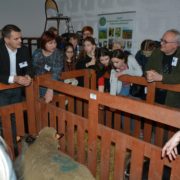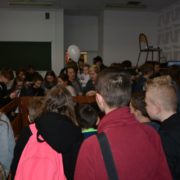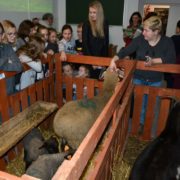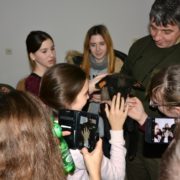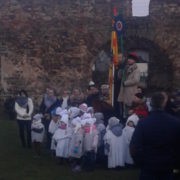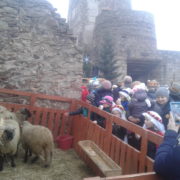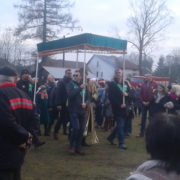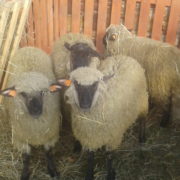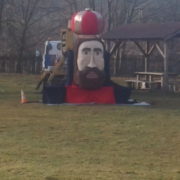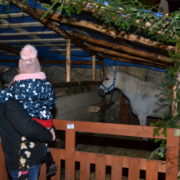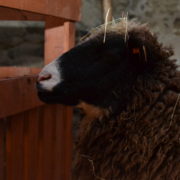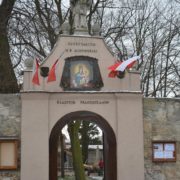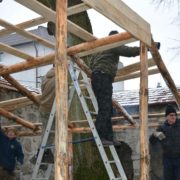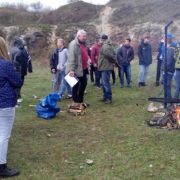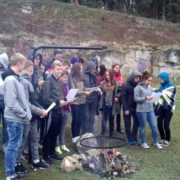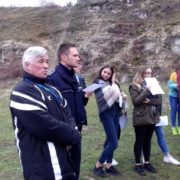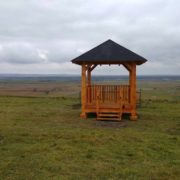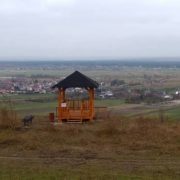News
Night of Biologists
The sheep with two seven-week lambs was an unquestionable attraction of the Night of Biologists organized on 12th January by the Jan Kochanowski University in Kielce. It was difficult to get to it at times. No wonder. Everyone wanted to touch, stroke, take a picture. The sheep bravely endured this interest and attempts to feed them.
For the LIFE team, it was another opportunity to inform about our project and the role of sheep and goats in the protection of the xerothermic turfs of Ponidzie.
The Cavalcade of Magi took place in Samsonów for the fourth time
It was the fourth time that the „Cavalcade of Magi” took place in Samsonów, attended by several hundred inhabitants of the Zagnańsk commune. After the mass at the Church of the Blessed Virgin Mary, a procession passed the streets of Samsonów and went to the Józef Steelworks. The three processions represented three continents: the green one represented Asia, the red one represented Europe and the blue one represented Africa. Children dressed as sheep walked in front of the Cavalcades of Magi. At the request of the organizers we have prepared a „live nativity scene” as in the previous year. As always, our blackhead sheep from Piotr Mider’s flock from Młodzawy attracted the interest of not only the youngest. They were a bit intimidated, maybe because of the fact that they graze in the thermophilous oak tree forest on a daily basis and do not have contact with such a large audience. However, they endured the guest performances well and happily returned to the fold.
Carlina onopordifolia
Our carlinas, planted on the plantation, fruited. The fruit themselves may not be very spectacular, because they are what botanists call „achenes”, i.e. fruit that do not crack, containing a single seed, having a leathery or woody pericarp, loosely surrounding the seed.
However, the amount of fruit that one flower produces is impressive, and each fruit is decorated with a delicate down of regular shapes. The radially arranged individual fibers form a sort of an umbrella. It is a pappus, which is a kind of a aeriform apparatus that allows the fruit to be carried by the wind over long distances. In nature, however, only a few seeds reach places where new plants can grow.
The carlina grows only on shallow rendsinas formed on the slopes of carbonate hills which face south-west. So we help nature. The collected seeds will be used to grow young seedlings under greenhouse conditions, which will be planted in natural places to ensure the survival of this rare and protected plant in Ponidzie.
Living nativity scene
The tradition of the live animals crib dates back to 1223, when in the Italian town of Greccio, St. Francis decided to recreate the atmosphere of the birth of Christ. With the Pope’s consent, he prepared a manger, hay, and brought in an ox and a donkey. In 1992, the Franciscans from the Krakow seminary organized the first crib of this kind in Poland. In Pińczów, a live nativity scene can be seen for the second time in the Franciscan monastery. It is very popular among the inhabitants, and carol singing at the nativity scene is an attraction not only for children.
All the best!
It was a good year. We are very pleased that our work has brought measurable effects for the Ponidzie wildlife. Protected plants are in an increasingly better condition and the tourist infrastructure under construction is beneficial for wanderers. We would like to thank everyone for their good cooperation, especially the shepherds from Ponidzie.
Pastuszkowie bracia mili
gdzieście przez ten rok chodzili
…Poszliśmy hen ku dolinie
tam gdzie rwąca Nida płynie
paść owieczki
On the occasion of the upcoming holiday season, we wish all our friends to have a happy Christmas, spent in harmony, joy and family atmosphere. We wish you and your loved ones good health in 2018. We wish you every success and successful fulfillment of all your plans.
ALL THE BEST!
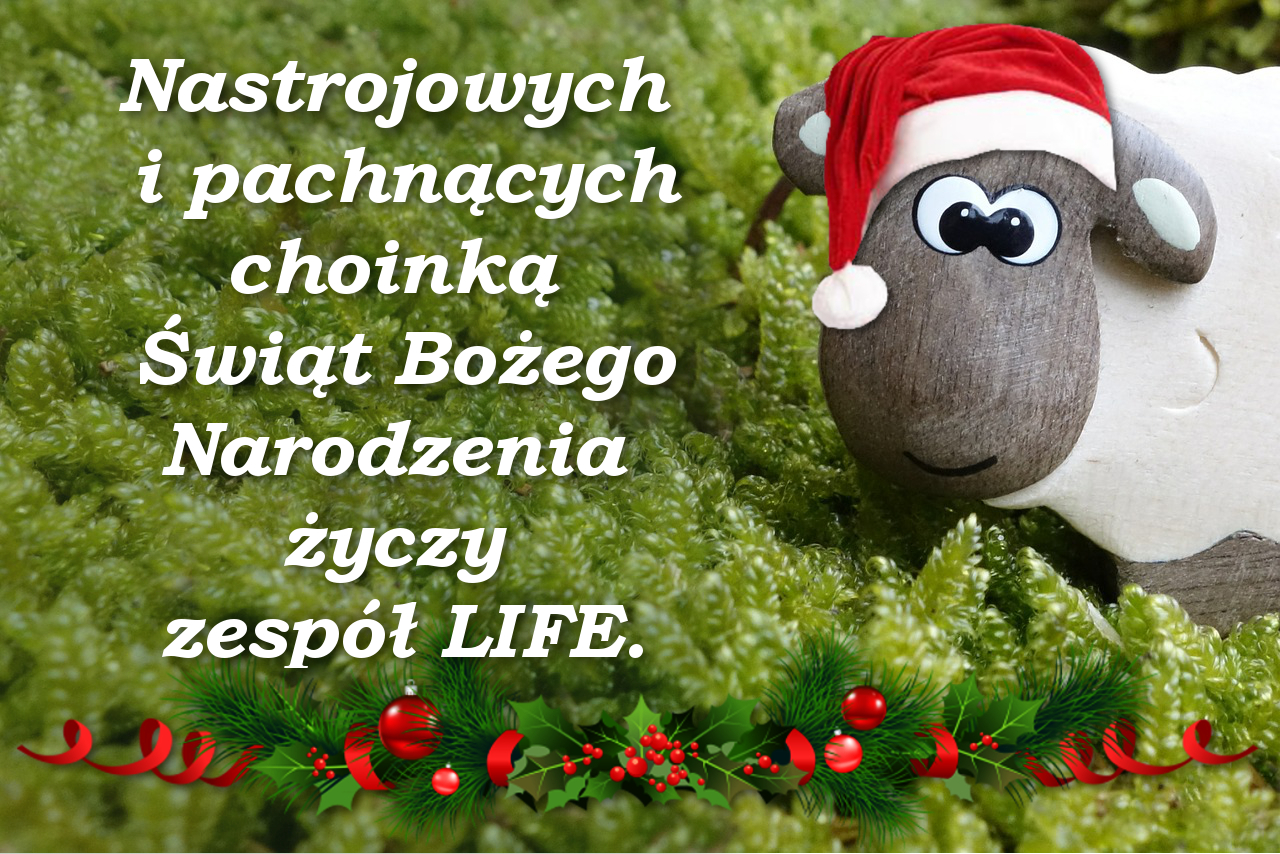
We are building a crib
krok po kroku
Najpiękniejsze w całym roku
Idą święta
Once again, the LIFE + crew is building a Christmas crib in the courtyard of the Franciscan Fathers Monastery in Pińczów. Thanks to the cooperation with the Pińczów Town Hall and the Franciscans, Ponidzie will be enriched with a great attraction for Christmas.
We are sure that as in the previous year, the „living” nativity scene will be besieged not only by children but also by tourists visiting Ponidzie.
We would like to thank Mr. Paweł Wójcik and Mr. Antoni Chmielewski for lending the animals.
See you at the nativity scene.
Meeting of the Steering Committee
The annual meeting of the Steering Committee of our project took place on November 29th at the headquarters of the Świętokrzyskie and Nadnidziadzkie Landscape Parks Complex. It was an opportunity to summarize the works carried out in 2017. It was presented by Wojciech Sołtysiak – LIFE Project Manager. The participants of the meeting also listened to three scientific presentations regarding Ponidzie.
Ponidzie xerothermic turfs are a very rich accumulation and many of the plant species present there have therapeutic value. The lecture „Utility characteristics of xerothermic habitat plants” was given by Prof. Małgorzata Jankowska – Błaszczuk, PhD, from the Institute of Biology of the Jan Kochanowski University in Kielce. The healing properties of the pheasant’s eye, which is used to prevent hypertension, are commonly known, and lemon thyme has been used since ancient times as a seasoning for meat and its disinfecting, antibacterial and expectorant effect has been well known. However, many other plants present in Ponidzie also have medicinal properties: asparagus, golden flax, yarrow, stiff hedgenettle, wild basil and yellow chamomile – these are just some of them.
The next lecture was given by Prof. Janusz Łuszczyński, PhD, from the Institute of Biology of the Jan Kochanowski University. He has given the presentation „Mushrooms of xerothermic turf and thermophilous oak forest in Ponidzie and in the Świętokrzyskie Mountains”. It turns out that in thermophilous oak tree forests, which are the floristically richest type of forest, there are also many species of mushrooms. As a result of the research, even species previously unknown from Poland were discovered, such as Bovista limosa – a fungus, which does not even have a Polish name. On the basis of the observation of the flocks grazed in Młodzawy, it can be stated that our sheep eagerly eat mushrooms, which they treat as a variety of their diet.
The meeting of the Steering Committee was concluded with a presentation by Andrzej Junkuszew, PhD, from the Sub-Department of Small Ruminant Breeding and Professor T. Efner Research Station from the University of Life Sciences in Lublin, entitled „Welfare of grazed animals in Ponidzie”. It was an initial discussion of the research conducted by the team headed by Prof. Tomasz Gruszecki, PhD. It covered sheep grazed in Młodzawy and Stawiany. The flocks assessment was very good. The animals are healthy and in good physical and mental condition. This means that flocks are cared for properly. This assessment was welcomed by our flock keepers, who also participated in the meeting.
Births
New births started in our herds. It is worth reminding that sheep we “employed” perfectly sustain the conditions we have in Ponidzie and long grazing during the entire vegetative period. The climate and topography of our land subject to active protection make it a perfect place to live for sheep of this breed, which is particularly well adapted to highlands. Our black-headed sheep also perfectly sustain nights on a pasture in a mobile sheep pen.
The first births this year took place on Paweł Wójcik’s farm in Pińczów.
Preventive Patrol
In the picturesque scenery of the medieval quarry situated on Garb Pińczowski, another preventive patrol was carried out. This time, a guest of the students of the Secondary School and the Post-middle School Complex No. 1 in Pińczów was a historian and well-known regionalist, dr Cezary Jastrzębski. He strongly emphasised the natural wealth of Ponidzie, its history, and the necessity to protect this amazing place located in the post-quarry area, which once served as a stone excavation site for great architectural undertakings of the Middle Ages and the Renaissance.
The quarry on Góra Okrąglica was already exploited as early as in the 12th century. The stone from the quarry – explained dr C. Jastrzębski – was used to erect the Cistercian monastery in Jędrzejowo, Saint Anna’s Chapel, and a range of buildings in the royal Cracow. The collection of litter scattered all over the entire post-quarry area was a wonderful educational idea. We hope that it will affect the behaviour of the young people in the future and it will make them guardians of this exceptional site.
Because both in the quarry and its vicinity active protection of endangered plants is carried out, the patrol has become an opportunity to learn about this form of activity of the Parks. Another exciting attraction for young people was observation of a herd of sheep grazing nearby… with a lama as a guide. At a bonfire, the students attentively listened as a police officer from the County Police Headquarters in Pińczów talked about the penal consequences for devastation and littering of protected areas and about how to light a bonfire safely and how to behave in a protected area.
The patrol was finished with time spent together at a bonfire. In the opinion of one of the teachers participating in the action, it turned out to be an amazing lesson about nature and citizenship.
Enriching the Infrastructure
On 16 October, we put to use morepieces of tourist landscape furniture. This time, on the slope of Okrąglica and in the Skowronno reserve near Pińczów, observation platforms were installed along with necessary infrastructure, such as bicycle stands and rubbish bins.
This should certainly make walks more pleasurable for tourists and contribute to the protection of those unique natural places.
The platforms were made by Studio 7, a company from Sobkowo.
- Skowronno Dolne
- Serpentyny













